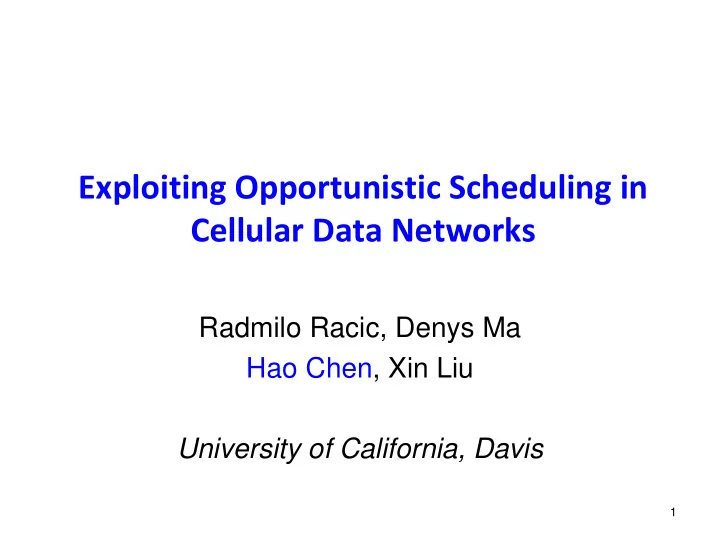

Exploiting Opportunistic Scheduling in Cellular Data Networks Radmilo Racic, Denys Ma Hao Chen, Xin Liu University of California, Davis 1
3G Cellular Networks • Provide high speed downlink data access • Examples – HSDPA (High Speed Downlink Packet Access) – EVDO (Evolution-Data Optimized) • Approach: exploring multi-user diversity – Time-varying channel condition – Location-dependent channel condition • Opportunistic scheduling – Embracing multi-user diversity 2
TDM (Time Division Multiplexing) • Base station use TDM to divide channels into time slots • TTI (Transmission Time Interval) – HSDPA: 2 ms – EVDO: 1.67 ms 3
Opportunistic Scheduling • Assumptions – Phones’ channel conditions fluctuate independently – But some varying set of phones may have strong channel conditions at any moment • Opportunistic scheduling – Phones measure and report their CQIs (Channel Quality Indicators) to base station periodically – Base station schedules a phone with good channel condition 4
Proportional Fair (PF) Scheduler • Motivation: strike a balance between throughput and fairness in a single cell • Goal: maximize the product of the throughput of all users 5
PF Algorithm CQI i ( t ) argmax Base station schedules R i ( t ) i CQI ( t ) : Instantane ous channel condition of user i i R ( t ) : Average throughpu t of user i , i often calculated using a sliding window ⎧ R i ( t ) = α CQI i ( t ) + (1 − α ) R i ( t − 1) if i is scheduled ⎨ (1 − α ) R i ( t − 1) ⎩ otherwise 6
PF Vulnerabilities • Base station does not verify phone’s CQI reports – Attack: malicious phones may fabricate CQI • PF guarantees fairness only within a cell – Attack: malicious phones may exploit hand offs • Design flaw: cellular networks trust cell phones for network management 7
Attacks • Goal: malicious phones hoard time slots • Two-tier attacks – Intra-cell attack: exploit unverified CQI reports – Inter-cell attack: exploit hand off procedure • We studied attack impact via simulation 8
Threat Model • Assumptions – Attackers control a few phones admitted into the network, e.g.: • Via malware on cell phones • Via pre-paid cellular data cards – Attackers have modified phones to report arbitrary CQI and to initiate hand off • We do not assume that attacker hacks into the network 9
Intra ‐ cell Attack • Assumption: attacker knows CQI of every phone (we will relax this assumption later) • Approach: at each time slot, attackers ( ) CQI t i – Calculate CQI i (t) required to obtain max R ( t ) i – Report CQI i (t) to base station 10
11 Results from Intra ‐ cell Attack
12 Inter ‐ cell Attack
13 Results from Inter ‐ cell Attack Timeslots Occupied
Attack without Knowing CQIs • Problem CQI ( t ) max i – Attack needs to calculate R ( t ) i i ( ) CQI t i – But attacker may not know the every phone’s R ( t ) i c ( t ) = max CQI i ( t ) • Solution: estimate R i ( t ) i ⎧ c ( t + 1) = c ( t )/(1 − ε ) if attacker is scheduled ⎨ c ( t )/(1 + σ ( c ( t ) − 1)) ⎩ otherwise 14
15 Results from Unknown CQI Attack Timeslots Occupied
16 CQI Prediction Accuracy
Attack Impact on Throughput • Before attack – 40-55 kbps • After attack (1 attacker, 49 victim users) – Attacker: 1.5M bps – Each victim user: 10-15 kbps 17
Attack Impact on Average Delay • Before attack – 0.01s between two consecutive transmissions • After attack (in a cell of 50 users) – One attacker causes 0.81s delay – Five attackers cause 1.80s delay • Impact: disrupt delay-sensitive data traffic – E.g.: VoIP useless if delay > 0.4s 18
Attack Detection • Detect anomalies in – Average throughput – Frequency of handoffs • Limitations – Difficult to determine appropriate parameters – False positives 19
Attack Prevetion • Goal: extend PF to enforce global fairness during hand-off • Approach: estimate the initial average throughput in the new cell • Estimate average throughput as: R = E ( CQI ) G ( N ) N E ( CQI ) : expection of CQI G ( N ) : opportunistic scheduling gain N : number of users 20
Attack Prevention (cont.) E ( CQI B ) G ( N B ) G ( N B ) R B N B N B = ≈ E ( CQI A ) G ( N A ) G ( N A ) R A N A N A 21
Related Work • Attacks on scheduling in cellular networks – Using bursty traffic [Bali 07] • Other attacks on cellular networks – Using SMS [Enck 05] [Traynor 06] – Attacking connection establishment [Traynor 07] – Attacking battery power [Racic 06] 22
Conclusion • Cellular networks grant unwarranted trust in mobile phones • We discovered vulnerabilities in PF scheduler – Malicious phone may fabricate CQI reports – Malicious phone may request arbitrary hand offs • Attack can severely reduce bandwidth and disrupt delay-sensitive applications • Propose to enforce global fairness in PF to prevent attack 23
Recommend
More recommend